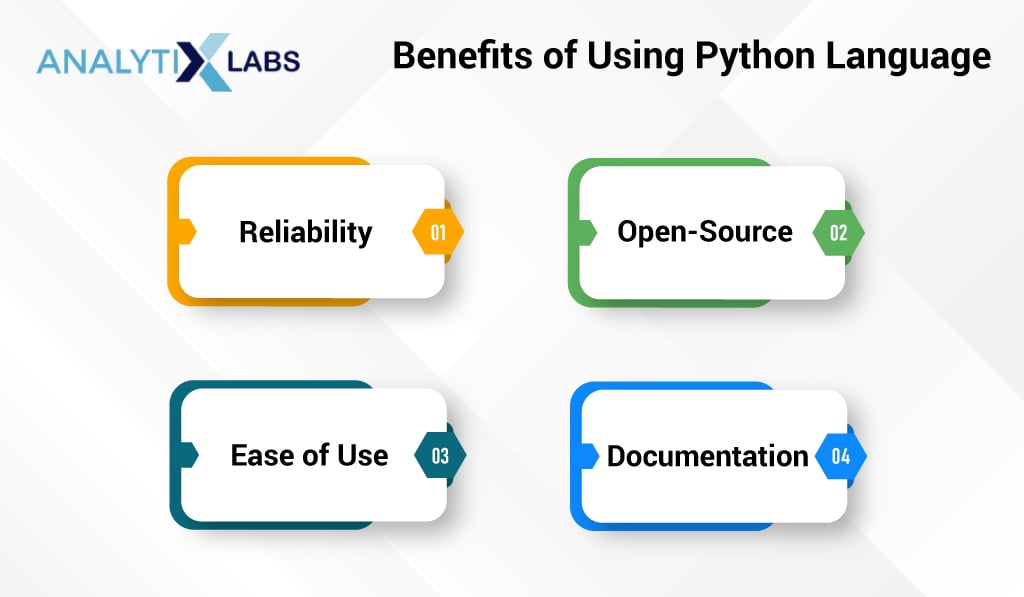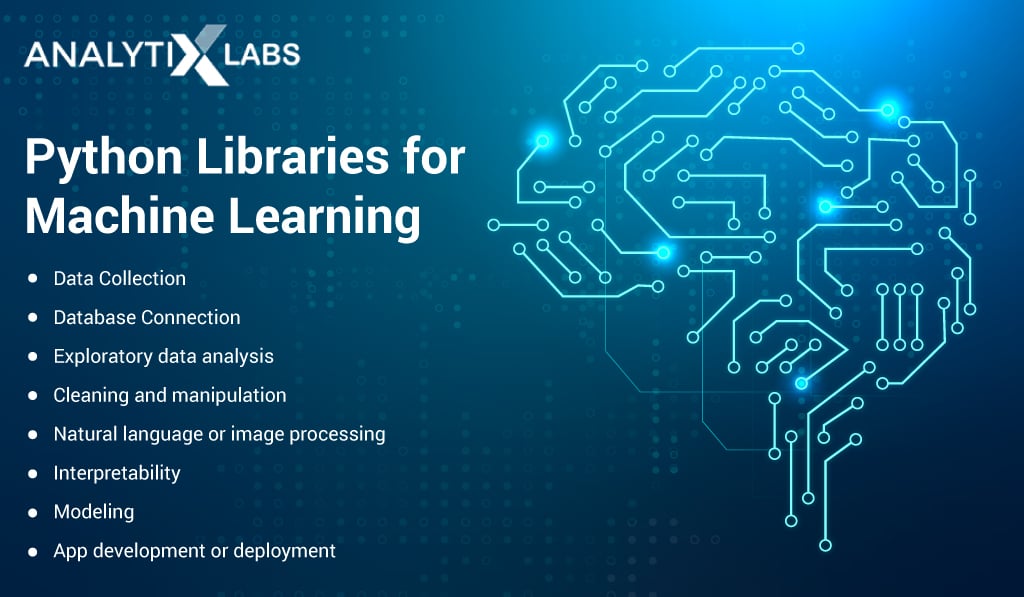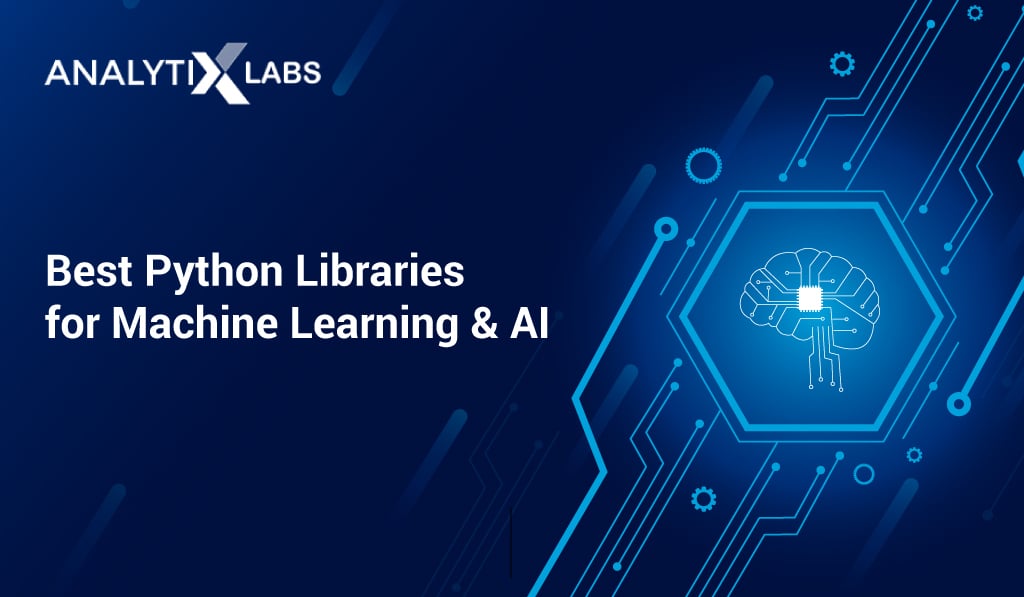Machine learning is defined as the science that enables computers to learn without being programmed explicitly. Previously, most of the machine learning tasks were done manually like coding the algorithms and statistical formulas manually. This was time-consuming and inefficient. Over time, all of this became easy with various Python libraries, modules, and frameworks. Since Python is one of the most popular languages for Machine Learning and AI, it boasts a vast collection of libraries`.
You may also like: Why Python for Data Science is Industry’s Top Choice?
Python programming language – A brief history
What led to the widespread adoption of Python?
As machine learning, artificial intelligence, NLP, data mining, and data exploration domains expand, python libraries continue to develop so as to cater to all these fields.
In this article, we will explore the reasons to learn about Python libraries, its implications in Machine Learning, and the major Python libraries that are worth learning about. So, let’s dig in.
Why learn about Python libraries for Machine Learning?
Python has numerous machine learning libraries with incredible capabilities. Some of the major reasons to learn about Python libraries for machine learning are:

1. Reliability
Python has a large developer community, housing the best data scientists and machine learning engineers. This makes the Python libraries for machine learning of utmost quality. Also, these libraries are used by numerous companies and are critically analyzed by machine learning experts. All this makes it a good alternative to developing libraries from the scratch, since developing an ML algorithm based on a white paper can consume significant time as well as resources.
2. Open-source
The source code of most Python libraries, including the machine learning libraries, is publically available. Often the papers on which the python machine learning library is based are also provided by the developer for the community to vet before using it. This allows the users to look at the code, identify bugs, and modify the codebase to create a separate version that suits their needs. Thus, this makes the use of Python for ML more lucrative as it allows data scientists to alter the algorithm if it makes sense to them.
3. Ease of use
The Python machine learning packages are effortless to use. Complex tasks such as hyperparameter tuning, cross-validation, and algorithm selection can be done quickly and efficiently. This helps speed up the model development and allows individuals with relatively less traditional programming experience to get into the field of machine learning.
4. Documentation
The ML libraries available in Python often have extensive documentation prepared by the module developers. This documentation explains ways to use the python machine learning library as well as the underlying concept of the ML algorithm employed through the library. Users become more capable of making an informed decision when creating an ML model and performing associated tasks such as hyperparameter tuning and so on.
Having said that, let’s move on to the best Python libraries for machine learning that are worth your time in 2024 and beyond.
You may also read: The Best Machine Learning Tools: Python vs. R vs. SAS
Best Python Libraries to start learning
Python libraries that perform data modeling by implementing various machine learning algorithms are important. However, those that aid the model development processes are equally important. These include:
- Supplementary libraries responsible for data collection
- Database connection
- Cleaning & manipulation
- Exploratory data analysis
- Visualization
- Natural language processing
- Image processing
- Interpretability
- App development/deployment
Let’s take a look at some of these libraries.

(i) Data Collection
Specific libraries can be used to extract data from websites such as Request and Beautiful Soup without needing to run JavaScript. More powerful libraries such as Selenium or Scrapy can also be used for web automation or to export large amounts of data to databases.
(ii) Database Connection
ML models require a considerable amount of data to train on, and this data is often available on databases. Here libraries like SQAlchhemy can be used to connect to SQLite database, or Pyscopg can be used to use PostgreSQL DBMS.
(iii) Exploratory Data Analysis
“Garbage in, garbage out” is the theory followed by every ML model. This means that if the quality of the data on which the ML model is being trained is abysmal, the output provided by the model will be of the same quality. Therefore, it becomes crucial to explore and understand the data before using it. Here python libraries like Pandas Profiling and PyOD can be used. Exploration is also done visually through the graph, and for this, matplotlib and seaborn can be used.
(iv) Cleaning and Manipulation
Machine learning models require clean data that includes data being structured, scaled, devoid of missing values, outliers, etc. Here data is manipulated that can be done by libraries like Spacy (if dealing with text) or Numpy and Pandas (if dealing with traditional panel or time series data).
(v) Natural Language or Image Processing
Machine Learning models are used not only with traditional structured data but also with other types of data such as text or images. NLTK or Spacy can be used for dealing with text, and with images, libraries like OpenCV or Scikit-Image can be used. They help make the data structured and comprehendible as per the needs of a Machine Learning model.
(vi) Interpretability
The biggest issue with Machine Learning models is their ‘BlackBox’ nature, i.e., their lack of interpretability. Unlike statistical models, machine learning models cannot provide the reason for the predictions. This is where libraries like Lime, Shap, or even H20 are helpful in identifying how variables are involved in predictions.
(vii) Modeling
While all the libraries mentioned above aid the model-building process, the libraries that create such models are Scikit Learn, XGBoost, LightGBM, CatBoost, PyBrain, etc. While the most generic and commonly used one is Scikit Learn, other specialized libraries like XGBoost and LightGBM implement specific types of tree-based machine learning algorithms.
(viii) App Development or Deployment
Finally, once a machine learning model is created satisfactorily, it needs to be sent into production, i.e., it is deployed, and here libraries like Flask, Django, or Pyramid are used. For a simplistic implementation (often used for proof of concepts), libraries like Streamlit are used.
These are some of the libraries that you must learn to make a mark in machine learning.
⇒Looking to make a career in machine learning? Start with our meticulously designed machine learning course that includes Python programming language. You can also start with Data Science with Python course.
Benefits of using Python for machine learning
While many languages can develop Machine Learning-based models, Python stands out for several reasons. Apart from the benefits already discussed, this language in itself has some intrinsic advantages that make it the first choice for machine learning engineers. Some of the advantages are as follows:
(i) Automation
The increased need for automation has paved way for many machine learning products. For example, typical implementation includes anomaly detection or self-driving cars, where Machine Learning induces ‘intelligence’ in the automation processes. Python is a general-purpose, object-oriented language that makes it easy to automate tasks like these.
(ii) Community
A machine learning model development cycle can go through several hiccups. While one can refer to books or ask their co-workers, it’s often the online community of users that come to the rescue when dealing with issues. This creates a self-fulfilling loop as Python has a lot of users that resolve problems on websites like StackOverflow. And as more people join the language, the community and its support get bigger and stronger, making it more attractive for anyone at crossroads, to select Python as the language for developing Machine Learning models.
(iii) Operating System Platform Independence
A significant advantage of using Python is that it is compatible with multiple operating systems. This includes Windows, macOS, Linux, etc. This is helpful as many model developers use Google and Amazon services for model development while using the various operating systems on their machines. It can pose a problem if the language isn’t platform-independent, but not with Python.
(iv) Integration
A Machine Learning project can be highly dynamic. While Python can perform many tasks and has enough libraries to accomplish them, there are times when it’s more beneficial and efficient to use lower-level languages. These include languages like Java, C++, or even C.
As Python can be easily integrated with such languages, Machine Learning engineers with knowledge of other languages can integrate Python and other languages into their Machine Learning projects. This is important in several situations like when some tasks can be best done in Java and so on. The easy integration of Python with other languages makes the whole development to production process efficient.
(v) Complimentary Libraries
To create a Machine Learning model, users not only require those libraries that develop such models but also a bunch of libraries that are required before or after the model creation. This includes libraries for data fetching, cleaning, manipulation, exploration, reduction, standardization, visualization, deployment, etc. Python provides an extensive range of libraries that makes Machine Learning model building easy.
(vi) Visualization Capabilities
Graphs are a helpful tool in understanding how well a machine learning model is working. However, unlike simple graphs (pie charts, histograms, etc.), Machine Learning-based graphs can be tricky. Python provides seaborn and various other dedicated libraries to help visualize concepts such as decision boundary, line of best fit, etc.
(vii) Learning Curve
Anyone involved in machine learning-based model development has a lot on his/her plate. This includes the deep theoretical knowledge of machine learning algorithms, data structures, business understanding, etc. If on top of all this, the tool implementing these concepts is complex, then the task of the model building can become complicated.
Python is not just capable of developing highly complex Machine Learning models, it is straightforward to use and doesn’t have a steep learning curve. The code is such that it can be understood even by someone with minimal knowledge of programming.
(viii) Cost
Many companies involved in machine learning are startups or medium-level companies that don’t have a lot of cash to spare. Python is open-source and essentially free, making it possible for such companies to hire a large workforce and pay them handsomely. The open-source nature of Python also makes the language quickly adapt to new Machine Learning algorithms by providing new Machine Learning libraries (that are often highly specialized) on a regular basis.
(ix) Easy to create prototypes
It is always advisable to develop Machine Learning-based products in an iterative manner. The ideal workflow is:
- First to develop an MVP (minimum viable product)
- Test how well it is performing
- Identify its shortcoming
- Go on to make it relatively more complex
- Scale it up
As the discipline of Machine Learning can employ a lot of complex algorithms and many time-consuming techniques can be used, it’s better to create multiple prototypes of the product before using all the complex and advanced methods available. Python is a straightforward language, that allows users to make such prototypes in a short time, which reduces the overall cost and wasteful expenditure.
This technique is common in Silicon Valley and is now employed in other fields, such as rocket science. For example, unlike NASA, SpaceX creates a prototype, identifies the causes of its failure, and quickly creates another prototype addressing the previously identified issues until they develop a fully functional prototype that is then sent into production. A Machine Learning product follows a similar concept, and python aids this development philosophy.
(x) Consistency
With standardization guidelines such as ‘zen of python’ that most of the community follow, the python code remains consistent. This makes code sharing easy. Also, a lot of pre-written codes can be found online. Owing to the standardization and consistency of the code, users can ‘lift and shift’ complex Machine Learning python code and use it in their projects. This dramatically cuts time and makes the project development cycle shorter.
This brings us to the end of our discussion of how and why use Python libraries for machine learning. While we have tried our best to cover all major topics, there might still be some questions in your mind. Below are a few commonly asked questions. If you have more queries, feel free to drop in your queries in the comments section below.
Python Libraries for Machine Learning: FAQs
1. Is Python good for machine learning?
Python is highly recommended for anyone venturing into the field of machine learning. There are numerous reasons for it.
- Python is easy to learn and fast-tracks you to get into the world of Machine Learning.
- Machine Learning libraries available in Python are relatively easy to use.
- With a large amount of documentation of these libraries and easy troubleshooting because of the size of the community using these libraries daily, you don’t feel lost and can overcome any hurdle.
- In addition to this, most of the companies involved in machine learning use python, which makes it an even more attractive option from a career point of view.
2. What Python libraries use Deep Learning and Machine Learning?
Python has multiple libraries that use Deep Learning and Machine Learning algorithms to train models. Some of the most popular ones are –
- Python Machine Learning Packages/Libraries
- Scikit-learn (most common python machine learning library)
- XGBoost
- LightGBM
- Pybrain
- Python Deep Learning Libraries
- TensorFlow (most common python deep learning library)
- PyTorch
- Apache MXnet
3. What is the use of Sklearn in Python?
Sklearn is one of the most commonly used and powerful libraries in Python. Sklearn is primarily used to create machine learning models and has capabilities to perform hyper-parameter tuning. However, along with data modeling, it can also perform other tasks related to model building, such as data split, feature reduction, and model evaluation & validation through numerous metrics. It is also used to provide inputs for creating certain kinds of graphs; for example, for creating calibration curves and ROC curves, sklearn, along with matplotlib is used.
You may also like to read:
Machine learning vs. Deep learning: Similarities and Differences
What is data processing in machine learning








